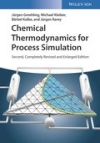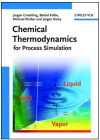AAE - Adsorbent/Adsorptive Equilibria

Adsorption of components from gaseous mixtures plays an important role in chemical engineering and environmental protection. The especially strong forces between a molecule in the vapor phase and adsorption sites on the adsorbent allow to separate components from gaseous streams at ambient or higher temperatures. In many cases, this process is much more energy efficient than cooling the stream so a sufficiently low temperature at which intermolecular forces could result in the formation of a liquid phase. For condensation, the fugacity of the component in the liquid would need to be lower than the fugacity in the vapor phase. Even if cooling would be economically feasible, condensation of only a small part of the gaseous stream often produces an aerosol of fine droplets that are difficult to separate from the gas stream. Adsorption is typically used to remove components of high volatility and higher partial pressure in the vapor phase or less volatile components that do not readily condensate due to their low partial pressure.
If more than one component adsorbs on the solid adsorbent, it is important to reliably calculate the composition of the adsorbed phase as a function of temperature and the partial pressures of the components in the gas or vapor phase.
Common adsorbents are active carbon, silica gel, and zeolithes. All these solids possess very large specific surfaces.
For the design of adsorption processes and the development of thermodynamic models to correlate and predict adsorption behavior, a large data base (DDB-AAE) was compiled and special software was developed for the correlation and prediction of these data (DDB-AAE).
The DDB Online Search shows all available adsorbent/adsorptive systems in this page.
Selected Scientific Papers
| 1999 | Comments on "Pure and Multicomponent Adsorption Equilibrium of Carbon Dioxide, Ethylene and Propane on ZSM-5 Zeolites with Different Si/Al Ratios" (Calleja, G. et al, J.Chem.Eng.Data 1998, 43, pp 994-1003) | Sakuth M., Sander S., Gmehling J. | Journal | J.Chem.Eng.Data, 44, 6, 1427 1428 (1999) |
| 1998 | Measurement and Prediction of Binary Adsorption Equilibria of Vapors on Dealuminated Y-Zeolites (DAY) | Sakuth M., Meyer J., Gmehling J. | Journal | Chem.Eng.Process., 37, 5, 267 277 (1998) |
| 1998 | Databank and Software Package for Adsorption Equilibria of Gases and Vapors | Sakuth M., Schweer A., Sander S., Meyer J., Gmehling J. | Journal | Chem.Eng.Technol., 21, 11, 866 869 (1998) |
| 1998 | Die Adsorptionsdatenbank - Datenbank und Softwarepaket fuer Adsorptionsgleichgewichte von Gasen und Daempfen | Sakuth M., Schweer A., Sander S., Meyer J., Gmehling J. | Journal | Chem.Ing.Tech., 70, 10, 1324 1327 (1998) |
| 1994 | Eine neue Methode zur Vorausberechnung von Gleichgewichten der Mehrkomponentenadsorption | Sakuth M., Meyer J., Gmehling J. | Journal | Chem.Ing.Tech., 66, 7, 940 945 (1994) |
| 1993 | Einfluss der Hydrophobizitaet von Y-Zeolioten auf das binaere Adsorptionsgleichgewicht Dampf/Feststoff | Sakuth M., Meyer J., Gmehling J. | Journal | Chem.Ing.Tech., 65, 5, 582 584 (1993) |
Selected Scientific Papers (Experimental Data)
| 1995 | Vapor Phase Adsorption Equilibria of Toluene + 1-Propanol Mixtures on Y-Zeolites with Different Silicon to Aluminum Ratios | Sakuth M., Meyer J., Gmehling J. | Journal | J.Chem.Eng.Data, 40, 4, 895 899 (1995) |


